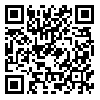

BibTeX | RIS | EndNote | Medlars | ProCite | Reference Manager | RefWorks
Send citation to:
URL: http://hcjournal.arums.ac.ir/article-1-116-en.html
Introduction: Considering
destructive nature of aggressive patients and failure of current controlling
plans of aggression in the emergency department, developing an effective
continuous care model in predicting, preventing and nursing care of these
patients is a nursing priority. One of the effective measures is using violence
Checklist.We aimed to evaluate the effects of nursing care on controlling
patients’ violence in emergency unit�of psychiatric hospital in Tehran
University of Medical Sciences.
Methods: In this case - control study, using convenience sampling method, 200 patients admitted
to Roozbeh Hospital in 2010 were assigned into
two groups of about 100 people each: standardized intervention and control (routine)
intervention. A questionnaire including demographic questions and Violence-imposed questions regarding
aggressive signs related to 6 domains(1-confusion 2-Irritability
and petulance 3- duress
and stormy behaviors 4-verbal threat
5-physical threat 6-�Attempted�assault
with�objects )was used to collect
the data. Nursing staff were educated for the intervention by standard
checklist based on patients’ aggression .Data
was analyzed with descriptive statistics, analytical tests (Chi-square
and Mann-Whitney) and Spearman
correlation using SPSS version 11.
Finding: Findings showed
that outcomes of physical threats control were better in case group compared to
control group (P= 0.008). There was no significant relationship between demographic data and scores of both groups and between age and
shift and duress and stormy
behaviors (0<0.05).
Conclusion: Both routine and
standardized intervention were effective in controlling aggressive patient
but outcomes of physical threats control
were better in case group (standardized intervention) compared to control group
(routine intervention). Therefore, adding some items of standardized
intervention to routine intervention protocol is an effective measure for the
prediction and prevention of patients’ violence in emergency wards.
| Rights and permissions | |
 |
This work is licensed under a Creative Commons Attribution-NonCommercial 4.0 International License. |


